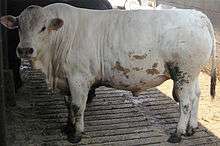Bianca Modenese
The Bianca Modenese or Modenese is a breed of dual-purpose cattle from the Po Valley, in the Emilia Romagna and Lombardy regions of northern Italy. It is raised for beef and milk production, but in the past was a triple-purpose breed, used also as a draught animal.[4]:39 The name derives from that of the province of Modena, where it is thought to have originated. In the nineteenth century it was concentrated in the area of Carpi, and was sometimes known as the Carpigiana. It was later distributed through much of the Po Valley, and thus also known as the Bianca della Val Padana.[4]:39
 Heifer | |
| Conservation status | FAO (2007): endangered-maintained[1] |
|---|---|
| Other names |
|
| Country of origin | Italy |
| Distribution | |
| Standard | MIPAAF (page 9) |
| Use | originally triple-purpose now meat and dairy |
| Traits | |
| Weight | |
| Height | |
| Skin color | unpigmented[3] |
| Coat | white; some grey shading in bulls |
| Horn status | horns small, forward-curving |
| |

History
The origins of the Modenese are unknown.[4]:40 It may derive from a mixture of Reggiana and Podolica stock; in 1889 it was still of very mixed appearance. The breed is first documented in the mid-nineteenth century, and officially known as the "Modenese" from 1880. Many cattle in the area were wheaten; from the last decades of the nineteenth century farmers recognised that white-coated animals yielded better-quality meat, and began to breed selectively for white colouring.[4]:40
The range and numbers of the Modenese expanded rapidly, particularly between 1927 and 1940. A breed standard was officially approved by the Italian ministry of agriculture in 1935, and the breed was renamed "Bianca Val Padana" to reflect its much greater area of distribution.[4]:40 In the early twentieth century there were 52,000 head registered; the total population was probably about 200,000. A census in 1944 recorded 140,000, and a further 100,000 under the name Carpigiana. Numbers began to decline after the Second World War: in 1955 the population was again estimated at 200,000, and the Modenese constituted about 52% of the cattle raised in the province of Modena; by 1968 this had fallen to 26%. A herd book was instituted in April 1957. By 2005 about 800 head remained, of which 258, including 11 bulls, were registered in the herd book.[4]:40 The Modenese was listed as "endangered-maintained" by the FAO in 1995,[5]:289 in 2000,[6]:309 and in 2007.[1]:66 In 2012 a total number of 1022 was reported.[2]
The Modenese is one of the sixteen minor Italian cattle breeds of limited diffusion recognised and protected by the Ministero delle Politiche Agricole Alimentari e Forestali, the Italian ministry of agriculture.[3]:2
Characteristics
The Modenese is white-coated; bulls may show some of the grey shading on the neck and shoulders typical of grey cattle. Bulls stand about 155 cm at the shoulder and weigh about 1050 kg; cows stand 145 cm and weigh 650 kg.[2] They occasionally exhibit double muscling.
Use
The Modenese is raised for milk and beef.
Because of long selection for draught use, it is willing and docile in nature, and may be used for draught work for tourism or for educational purposes.[4]:40
References
- Barbara Rischkowsky, D. Pilling (eds.) (2007). List of breeds documented in the Global Databank for Animal Genetic Resources, annex to The State of the World's Animal Genetic Resources for Food and Agriculture. Rome: Food and Agriculture Organization of the United Nations. ISBN 9789251057629. Accessed October 2015.
- Breed data sheet: Modenese/Italy. Domestic Animal Diversity Information System of the Food and Agriculture Organization of the United Nations. Accessed October 2015.
- Norme Tecniche del Registro Anagrafico delle razze bovine autoctone a limitata diffusione (Appendix 2 to DM di approvazione del Disciplinare del 20/12/2011; in Italian). Associazione Italiana Allevatori. Accessed October 2015.
- Daniele Bigi, Alessio Zanon (2008). Atlante delle razze autoctone: Bovini, equini, ovicaprini, suini allevati in Italia (in Italian). Milan: Edagricole. ISBN 9788850652594. p. 38–40.
- Beate D. Scherf (editor) (1995). World Watch List for Domestic Animal Diversity, second edition. Rome: Food and Agriculture Organization of the United Nations. ISBN 9251037299. Accessed October 2015.
- Beate D. Scherf (editor) (2000). World Watch List for Domestic Animal Diversity Archived 13 November 2009 at Archive-It, third edition. Rome: Food and Agriculture Organization of the United Nations. ISBN 9251045119. Accessed October 2015.
External links
- "Modenese breed". www.regionalcattlebreeds.eu. Eureca. Retrieved 25 June 2011.